25 Reasons to Visit Uganda in 2025: Discover the Pearl of Africa
Whether you’re an adventure seeker, a nature enthusiast, or a cultural explorer, Uganda has something extraordinary to offer. Now is the time to start planning your 2025 Uganda safaris, so to give you a helping hand, we’ve put together 25 great reasons to go.
From the mist-shrouded mountains where gorillas roam to the thundering waters of the Nile, Uganda promises experiences that will stir your soul and create memories to last a lifetime.
Join us as we explore why this East African gem should be at the top of your travel list for 2025.
- Gorilla Encounters: Trek through misty forests to meet gentle giants
- Chimpanzee Safari: Get up close with our closest relatives in their natural habitat
- Birder's Paradise: Spot over 1,000 avian species in a single country
- Big Five and Beyond: Experience classic African safari with a Ugandan twist
- Lions in the Trees: Witness the rare sight of climbing predators
- Hippo Haven: Watch these river giants from up close
- Nature's Palette: From rainforests to savannas, experience diverse ecosystems
- Lake Victoria's Majesty: Explore Africa's largest lake
- Nile's Birthplace: Stand where the world's longest river begins its journey
- Rwenzori Challenge: Hike the legendary "Mountains of the Moon"
- Cultural Kaleidoscope: Immerse yourself in Uganda's vibrant traditions
- Foodie's Delight: Savor unique flavors of East African cuisine
- UNESCO Wonders: Walk through globally recognized natural treasures
- Budget-Friendly Adventures: Affordable safari options for every traveler
- Luxury in the Wild: Indulge in high-end lodges amidst breathtaking nature
- Year-Round Paradise: Enjoy favorable weather whenever you visit
- Crowd-Free Exploration: Discover unspoiled, less-traveled destinations
- Travel with Purpose: Support local communities through responsible tourism
- Safe Travels: Experience peace of mind in the "Pearl of Africa"
- Language Ease: Navigate with comfort in this English-speaking nation
- Gateway to Adventure: Fly directly into the heart of East Africa
- Waterfall Wonders: Marvel at the powerful Murchison Falls
- Whitewater Thrills: Brave the rapids of the mighty Nile
- Primate Paradise: Encounter diverse monkey species in lush forests
- Ugandan Hospitality: Feel the warmth of Africa's friendliest people
- Book Your Next Uganda Safari With Kikooko Africa Safaris
Gorilla Encounters: Trek through misty forests to meet gentle giants

Uganda is home to over half of the world’s remaining mountain gorillas, offering an unparalleled opportunity to observe these magnificent creatures in their natural habitat.
Bwindi Impenetrable National Park and Mgahinga Gorilla National Park are the prime locations for this once-in-a-lifetime experience.
As you trek through the lush, misty forests, anticipation builds with every step. Suddenly, you’re face-to-face with a family of gorillas – their human-like expressions and behaviors leaving you in awe.
Witnessing these gentle giants in their natural environment is not just a tourist activity; it’s a profound connection with our closest relatives in the animal kingdom.
The strictly regulated permits ensure the gorillas’ protection while providing visitors with an intimate, respectful encounter. This extraordinary experience goes beyond mere wildlife viewing; it’s a journey that fosters a deep appreciation for conservation and the delicate balance of nature.
Chimpanzee Safari: Get up close with our closest relatives in their natural habitat
Uganda offers some of the best opportunities in Africa to observe chimpanzees in the wild.
Kibale National Park, often called the “Primate Capital of the World,” is the premier destination for chimpanzee tracking.
Here, you can watch these intelligent creatures swing through the trees, groom each other, and even use tools – behaviors that highlight our shared ancestry.
The Kyambura Gorge in Queen Elizabeth National Park, nicknamed the “Valley of Apes,” provides another unique setting for chimp encounters.
For a more immersive experience, Budongo Forest offers habituation experiences where you can spend a full day with a chimp family.
These encounters go beyond mere observation; they’re a window into the complex social structures and behaviors of our closest living relatives.
The thrill of hearing a chimp’s call echo through the forest or witnessing their human-like interactions is an experience that will stay with you long after your visit.
Birder’s Paradise: Spot over 1,000 avian species in a single country
Uganda is a birdwatcher’s dream, boasting an incredible diversity of over 1,000 bird species – nearly half of all bird species found in Africa.
This remarkable variety is due to Uganda’s position at the convergence of several ecological zones. From the shores of Lake Victoria to the slopes of the Rwenzori Mountains, each habitat offers unique birding opportunities.
The star attraction is the prehistoric-looking Shoebill, found in the Mabamba Swamp near Entebbe. In Bwindi Impenetrable Forest, you might spot the colorful Great Blue Turaco or the elusive African Green Broadbill.
The papyrus swamps of Murchison Falls National Park are home to the rare Papyrus Gonolek.
Whether you’re a seasoned birder or a casual enthusiast, Uganda’s avian diversity will leave you spellbound. With knowledgeable guides and well-maintained trails, you’re guaranteed to add numerous species to your life list while enjoying breathtaking scenery.
Big Five and Beyond: Experience classic African safari with a Ugandan twist
While Uganda might not be the first country that comes to mind for a Big Five safari, it offers this classic African experience with its own unique flavor. Murchison Falls National Park and Kidepo Valley National Park are your best bets for spotting lions, leopards, elephants, buffalos, and even rhinos (at the Ziwa Rhino Sanctuary). But Uganda’s safari experience goes far beyond the Big Five.
In Queen Elizabeth National Park, you can take a boat safari on the Kazinga Channel, watching hippos, crocodiles, and a myriad of water birds. The park is also famous for its tree-climbing lions – a rare behavior you’re unlikely to see elsewhere.
In Lake Mburo National Park, you can take guided walks among zebras, impalas, and giraffes. Uganda’s relatively uncrowded parks allow for more intimate wildlife encounters, and the stunning landscapes – from sprawling savannas to lush forests – provide a breathtaking backdrop to your safari adventures.
Lions in the Trees: Witness the rare sight of climbing predators

In the Ishasha sector of Queen Elizabeth National Park, visitors can witness a truly rare sight: lions that climb trees.
While lions occasionally climb trees in other parts of Africa, it’s an everyday behavior for the lions in this region, making it one of the best places in the world to observe this unusual phenomenon.
These tree-climbing lions often drape themselves over the branches of fig trees, sometimes sleeping up to 18 hours a day in their lofty perches. Scientists believe this behavior helps the lions escape the heat and biting insects on the ground.
Watching a pride of lions lounging in the trees, their tawny coats contrasting against the green foliage, is a surreal and unforgettable experience. It’s not just a unique photo opportunity, but a chance to observe a fascinating adaptation in one of Africa’s most iconic predators.
The Ishasha sector’s landscape of acacia-studded savanna and fig trees creates the perfect setting for this rare wildlife spectacle.
Hippo Haven: Watch these river giants from up close
Uganda offers some of the best hippo-watching opportunities in Africa. The Kazinga Channel in Queen Elizabeth National Park is a particular highlight, where hundreds of hippos congregate in the water.
A boat safari here brings you remarkably close to these massive creatures, allowing you to observe their social behaviors and hear their distinctive grunts and bellows. In Murchison Falls National Park, hippos gather at the base of the falls, creating a spectacular scene where wildlife and landscape merge.
For a unique perspective, consider a night drive in Lake Mburo National Park, where you might catch hippos grazing on land – a behavior rarely seen during daylight hours. These encounters offer more than just photo opportunities; they provide insight into the crucial role hippos play in their ecosystems.
Their presence shapes river systems and creates habitats for numerous other species, making them a keystone species in Uganda’s waterways.
Nature’s Palette: From rainforests to savannas, experience diverse ecosystems
Uganda’s landscape is a breathtaking mosaic of diverse ecosystems, each offering unique experiences and wildlife.
In a single trip, you can traverse misty montane forests in Bwindi, home to mountain gorillas, to the sprawling savannas of Kidepo Valley, where herds of buffalo roam.
The Rwenzori Mountains present alpine meadows and glaciers, a surreal sight on the equator. In contrast, the shores of Lake Victoria showcase tropical broadleaf forests teeming with primates and birds. Murchison Falls National Park offers a stunning combination of woodland, wetland, and savanna, intersected by the mighty Nile.
The Albertine Rift’s forests harbor species found nowhere else on Earth. This incredible diversity within a relatively small area not only makes for efficient and varied safaris but also highlights Uganda’s critical importance in global conservation efforts.
Each ecosystem tells a unique story of adaptation and survival, offering visitors a comprehensive view of Africa’s natural wonders.
Lake Victoria’s Majesty: Explore Africa’s largest lake
Lake Victoria, the largest lake in Africa and the second-largest freshwater lake in the world, forms Uganda’s southern border.
This vast inland sea, covering over 68,800 square kilometers, offers a multitude of experiences for visitors. The lake’s shores and islands are home to diverse wildlife, including monitor lizards, otters, and a myriad of bird species.
Fishing enthusiasts can try their luck at catching the massive Nile Perch, while bird watchers will be thrilled by the abundance of water birds, including the African Fish Eagle. The Ssese Islands, an archipelago of 84 islands in the northwestern part of the lake, offer pristine beaches, lush forests, and a glimpse into traditional fishing village life.
Beyond its natural beauty, Lake Victoria plays a crucial role in the region’s climate, economy, and as a source of the Nile River. A visit to its shores or a boat trip on its waters provides a unique perspective on this influential body of water.
Nile’s Birthplace: Stand where the world’s longest river begins its journey
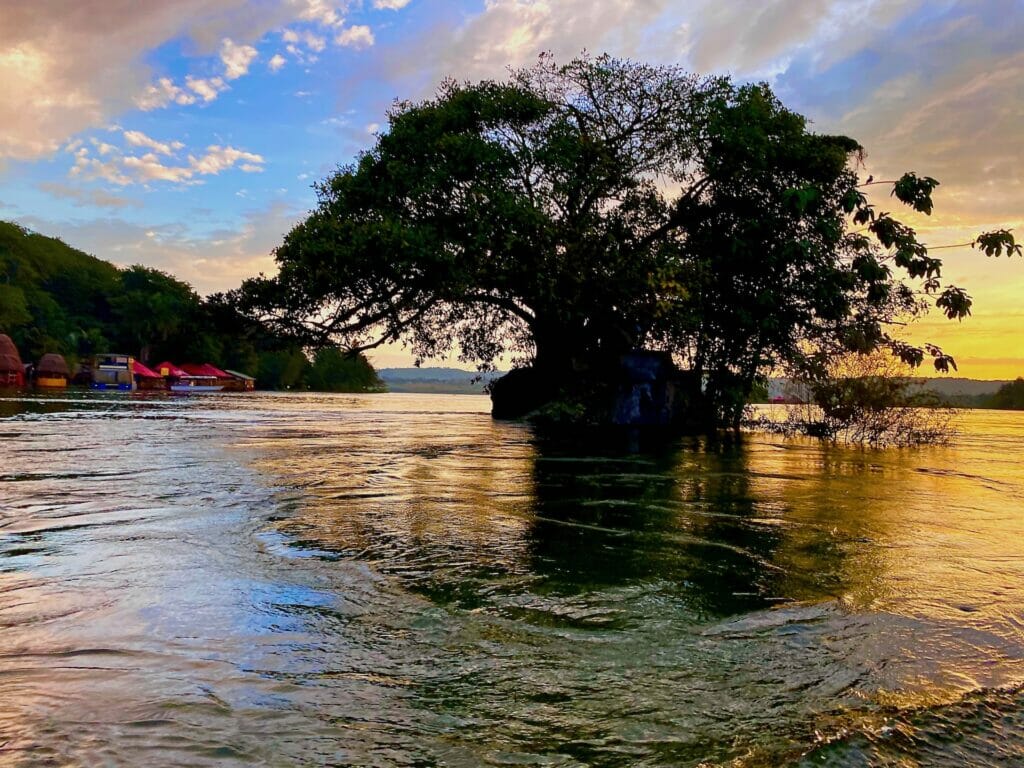
Uganda holds the distinction of being the source of the world’s longest river, the Nile. At Jinja, you can stand at the point where the Nile begins its 6,650-kilometer journey to the Mediterranean Sea.
This spot, where the river flows out of Lake Victoria, was discovered by John Speke in 1862, solving one of the greatest geographical mysteries of the 19th century. Today, it’s not just a historical site but a hub of adventure activities.
White-water rafting, bungee jumping, and kayaking allow visitors to experience the power of the young river firsthand. For a more serene experience, take a boat ride to the exact point where the lake becomes the river, marked by a modest monument.
As you watch the water begin its epic journey, you’re witnessing a geographical marvel that has shaped civilizations for millennia. It’s a profound moment that connects you to both natural history and human exploration.
Rwenzori Challenge: Hike the legendary “Mountains of the Moon”
The Rwenzori Mountains, also known as the “Mountains of the Moon,” offer some of Africa’s most challenging and rewarding hiking experiences. This UNESCO World Heritage site boasts Africa’s third-highest peak, Mount Stanley, standing at 5,109 meters.
The range is known for its otherworldly scenery: glaciers and snow-capped peaks on the equator, surrounded by moorlands with giant lobelias and groundsels, creating an almost surreal landscape. Trekking here is not just about reaching the summit; it’s a journey through five distinct vegetation zones, each with its unique flora and fauna.
The mountains are home to numerous endemic species, adding to the sense of exploration and discovery. While challenging, the trek is incredibly rewarding, offering breathtaking views and a sense of accomplishment.
Whether you opt for a day hike or a multi-day expedition, the Rwenzoris provide an unforgettable adventure that combines natural beauty, physical challenge, and rich biodiversity.
Cultural Kaleidoscope: Immerse yourself in Uganda’s vibrant traditions
Uganda is home to over 50 distinct ethnic groups, each with its own language, customs, and traditions, creating a rich tapestry of cultural experiences.
From the Baganda in the central region to the Karamojong in the northeast, visitors can engage with diverse communities and learn about their unique ways of life.
In Kampala, the Uganda Museum offers insights into the country’s cultural heritage, while the Kasubi Tombs, a UNESCO World Heritage site, provide a glimpse into the history of the Buganda Kingdom.
For a more immersive experience, visit local villages where you can participate in traditional dances, learn about ancient crafts, or even attend a local wedding ceremony. The Batwa pygmy communities near Bwindi offer cultural walks, sharing their forest-dwelling heritage.
These cultural interactions go beyond surface-level tourism, fostering genuine connections and understanding between visitors and local communities, making your Ugandan journey not just a trip, but a profound cultural exchange.
Foodie’s Delight: Savor unique flavors of East African cuisine
Ugandan cuisine is a delightful fusion of African, Arab, and Indian influences, offering a unique culinary experience.
The staple food, matooke (green bananas), is often served with groundnut sauce, creating a creamy, savory dish unlike anything you’ve tasted before. For meat lovers, the luwombo – a stew of chicken, beef, or fish steamed in banana leaves – is a must-try. Street food enthusiasts should sample the rolex, a rolled chapati filled with eggs and vegetables.
Uganda’s fertile soil produces an abundance of fresh fruits; try the sweet, juicy jackfruit or the tangy passion fruit. Coffee lovers will appreciate Uganda’s locally grown Arabica and Robusta beans. Don’t miss out on waragi, a local gin often flavored with banana essence.
Many lodges and restaurants offer cooking classes where you can learn to prepare traditional dishes. From bustling local markets to high-end restaurants in Kampala, Uganda’s food scene is an adventure in itself, reflecting the country’s cultural diversity and agricultural richness.
UNESCO Wonders: Walk through globally recognized natural treasures
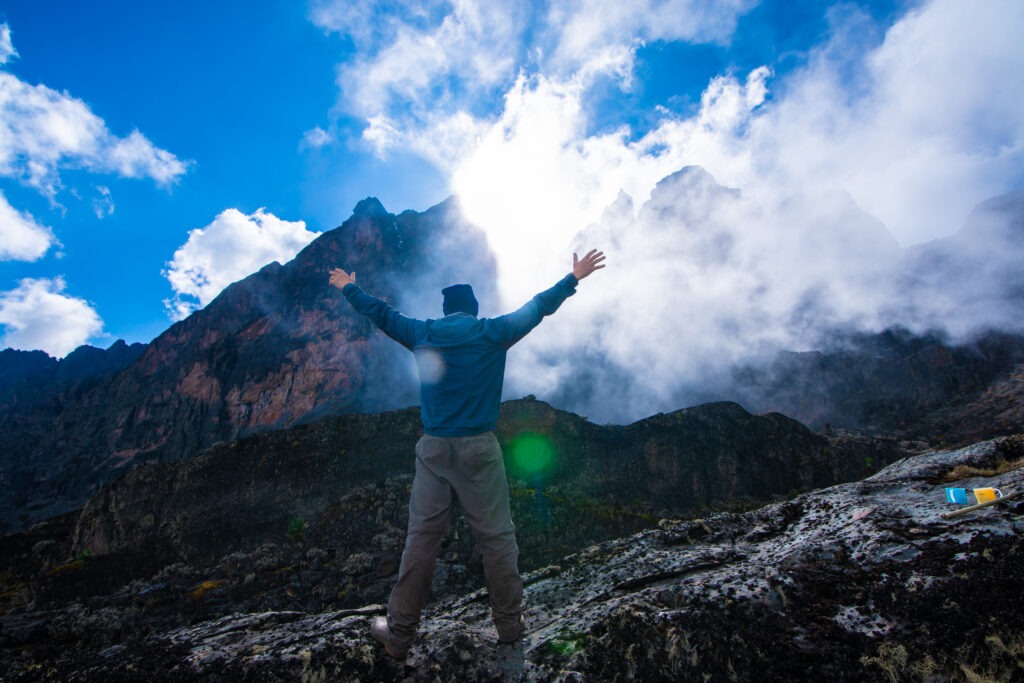
Uganda boasts three UNESCO World Heritage Sites, each offering unique and awe-inspiring experiences. Bwindi Impenetrable National Park, recognized for its exceptional biodiversity, is home to nearly half of the world’s mountain gorillas. Its ancient forest, dating back to the ice ages, harbors numerous endemic species of plants and animals.
The Rwenzori Mountains National Park, with its glaciers, waterfalls, and unique alpine vegetation, presents a surreal landscape often shrouded in mist. Lastly, the Kasubi Tombs, while currently under reconstruction, represent the spiritual heart of the Buganda Kingdom, showcasing traditional architectural techniques and cultural significance.
These sites aren’t just tourist attractions; they’re living museums of natural and cultural heritage. Visiting them provides insight into Uganda’s rich biodiversity, geological marvels, and cultural depth. Moreover, your visit contributes to their preservation, ensuring these wonders remain for future generations to experience and appreciate.
Budget-Friendly Adventures: Affordable safari options for every traveler
Contrary to the perception that African safaris are exclusively high-end experiences, Uganda offers a range of budget-friendly options that don’t compromise on adventure or wildlife encounters.
Many national parks, like Queen Elizabeth and Murchison Falls, have affordable accommodation options, from basic campsites to mid-range lodges. Uganda Wildlife Authority (UWA) bandas provide simple but comfortable accommodations within the parks at very reasonable rates.
Public transportation, while sometimes adventurous, can significantly reduce travel costs. Many tour operators offer group safaris that help spread the cost of guides and transportation. For those on a tight budget, day trips from Kampala or Entebbe can provide wildlife experiences without the expense of overnight stays.
Even gorilla trekking, typically a premium activity, can be made more affordable by visiting during low season or opting for gorilla habituation experiences. With careful planning, it’s possible to experience Uganda’s incredible wildlife and landscapes without breaking the bank, making it an accessible destination for a wide range of travelers. You can review our own Budget Uganda Safari here.
Luxury in the Wild: Indulge in high-end lodges amidst breathtaking nature
For those seeking a more indulgent safari experience, Uganda offers a selection of world-class luxury lodges set in stunning natural environments. These high-end accommodations seamlessly blend comfort with conservation, providing an immersive wildlife experience without sacrificing luxury.
Imagine soaking in a clawfoot bathtub while overlooking the savanna, or enjoying a gourmet meal on a private deck with views of grazing elephants. Lodges like Bwindi Lodge or Kyambura Gorge Lodge offer eco-luxury experiences, with solar power, locally sourced materials, and community involvement programs.
In Murchison Falls National Park, Baker’s Lodge provides luxury tented suites right on the banks of the Nile. These lodges often offer exclusive experiences like private game drives, bush dinners under the stars, or spa treatments using local ingredients. By choosing these high-end options, you’re often contributing directly to conservation efforts and local community development, allowing you to indulge in luxury with a clear conscience.
Year-Round Paradise: Enjoy favorable weather whenever you visit
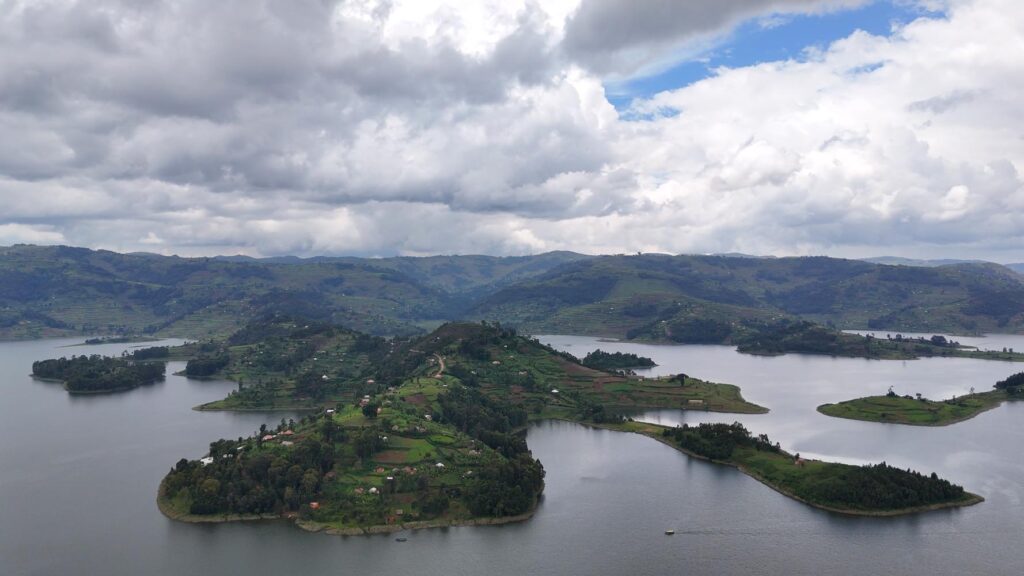
Uganda’s equatorial climate, tempered by its elevation, creates a year-round paradise for travelers. Unlike some African destinations with extreme seasonal variations, Uganda maintains relatively stable temperatures and conditions throughout the year.
The country experiences two dry seasons – from December to February and June to August – which are traditionally popular for wildlife viewing as animals congregate around water sources. However, the “green seasons” offer their own unique charm. March to May and September to November bring occasional rains that transform the landscape into a lush, vibrant green. These periods often offer better rates and fewer crowds.
Birdwatching is particularly spectacular during the wetter months as migratory species arrive. Even during the rainy seasons, downpours are typically short-lived and followed by sunshine. This climatic consistency means you can plan your trip based on your schedule rather than strict seasonal constraints, making Uganda a flexible destination for year-round adventures.
Crowd-Free Exploration: Discover unspoiled, less-traveled destinations
One of Uganda’s greatest appeals is its relative lack of crowds compared to more popular East African safari destinations. This means more intimate wildlife encounters and a greater sense of adventure and discovery.
In parks like Kidepo Valley, you might go a full day without seeing another vehicle, creating the feeling of having your own private wilderness. Even in more visited areas like Bwindi, strict limits on gorilla trekking permits ensure your experience remains personal and uncrowded. Lake Mburo National Park offers walking safaris where you can explore the bush on foot, rarely encountering other tourists.
The remote Ssese Islands in Lake Victoria provide pristine beaches often devoid of other visitors. This lack of crowds not only enhances your experience but also reduces stress on the wildlife and ecosystems. It allows for a more authentic connection with nature and local communities, free from the distractions of mass tourism.
In Uganda, you’re not just a spectator; you’re an explorer in your own right.
Travel with Purpose: Support local communities through responsible tourism
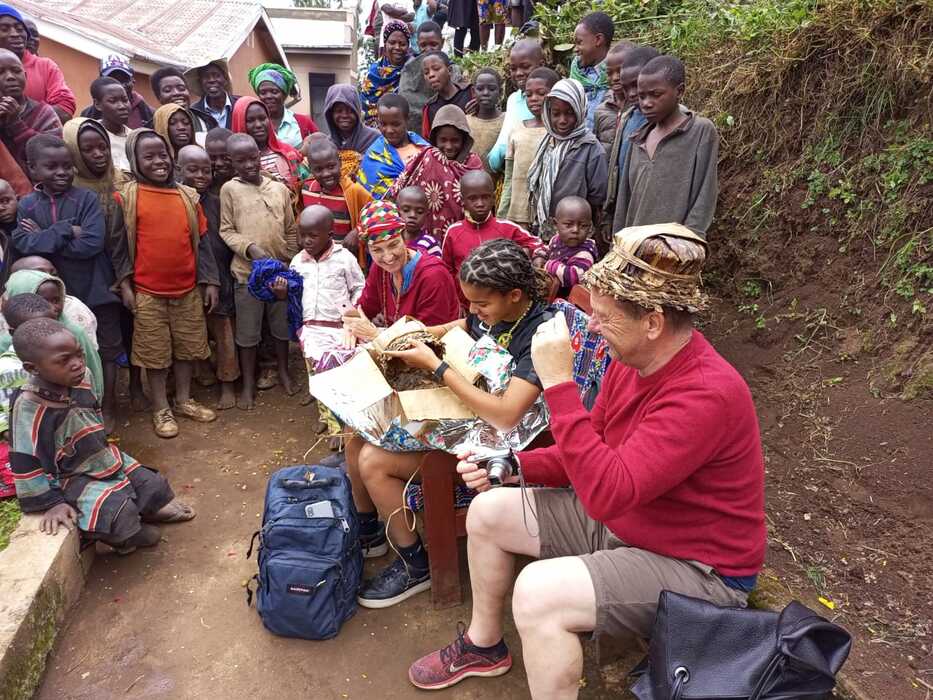
Uganda has embraced the concept of community-based tourism, allowing visitors to directly contribute to local development and conservation efforts. Many lodges and tour operators work closely with nearby communities, employing local staff and sourcing produce from local farmers.
In Bwindi, the Ride 4 a Woman initiative offers bike tours and homestays, empowering local women through tourism. The Batwa Experience near Mgahinga allows the indigenous Batwa people to share their culture and benefit from tourism after being displaced from their forest homes.
In Queen Elizabeth National Park, you can visit local fishing villages and support community craft initiatives. Many parks have revenue-sharing programs where a portion of park fees goes directly to community projects.
By choosing responsible operators and engaging in these community tourism initiatives, your visit becomes more than just a holiday; it’s a way to positively impact the places and people you encounter. This approach to travel creates meaningful connections and ensures that tourism benefits extend beyond the industry to local communities.
Safe Travels: Experience peace of mind in the “Pearl of Africa”
Uganda has come a long way in terms of safety and stability, shedding its turbulent past to become one of Africa’s safer travel destinations. The country has enjoyed over three decades of relative peace and growing prosperity.
While standard travel precautions apply, as they would in any destination, visitors to Uganda generally experience a warm welcome and a secure environment. The Uganda Tourism Board and the government have prioritized tourist safety, with trained tourism police present in major parks and attractions.
Health infrastructure for travelers has also improved, with many lodges and tour operators having partnerships with air ambulance services. It’s always advisable to check current travel advisories and take common-sense precautions, but most visitors to Uganda find their concerns about safety quickly dissolve in the face of the country’s genuine hospitality and well-managed tourism industry.
This combination of natural wonders, cultural richness, and a secure travel environment makes Uganda an increasingly attractive option for travelers seeking adventure with peace of mind.
Language Ease: Navigate with comfort in this English-speaking nation
As a former British protectorate, Uganda retained English as its official language, making it remarkably accessible for English-speaking travelers. This linguistic advantage extends beyond just ease of communication; it allows for deeper, more meaningful interactions with locals across all walks of life.
From your safari guide explaining the intricacies of elephant behavior to casual conversations with villagers about their daily lives, the shared language facilitates a richer cultural exchange. Road signs, menus, and important information are typically in English, reducing travel stress and potential misunderstandings. Moreover, many Ugandans are multilingual, speaking English alongside local languages, which can lead to fascinating discussions about linguistics and culture. You can read more about the languages of Uganda here.
For those interested in learning a few words of local languages, Ugandans are usually delighted to teach visitors basic greetings or phrases in languages like Luganda or Swahili.
This linguistic accessibility, combined with the legendary friendliness of Ugandans, creates an environment where travelers can easily connect, learn, and feel welcomed throughout their journey.
Gateway to Adventure: Fly directly into the heart of East Africa
Uganda’s Entebbe International Airport serves as a convenient gateway to East African adventures. With direct flights from major European, Middle Eastern, and African cities, getting to Uganda is easier than ever.
The airport’s location on the shores of Lake Victoria, just 40 kilometers from the capital Kampala, means you can start your Ugandan experience almost immediately upon landing. For those planning multi-country trips, Uganda’s central location makes it an ideal starting point. From Entebbe, you can easily connect to other East African destinations like Kenya, Tanzania, or Rwanda.
The Uganda Civil Aviation Authority has been working on modernizing and expanding the airport, improving facilities and increasing capacity. This investment in infrastructure reflects Uganda’s commitment to tourism and ensures a smooth arrival experience.
Whether you’re coming for gorillas, safari, or cultural experiences, flying into Entebbe puts you at the doorstep of diverse adventures, allowing you to maximize your time exploring the Pearl of Africa.
Waterfall Wonders: Marvel at the powerful Murchison Falls
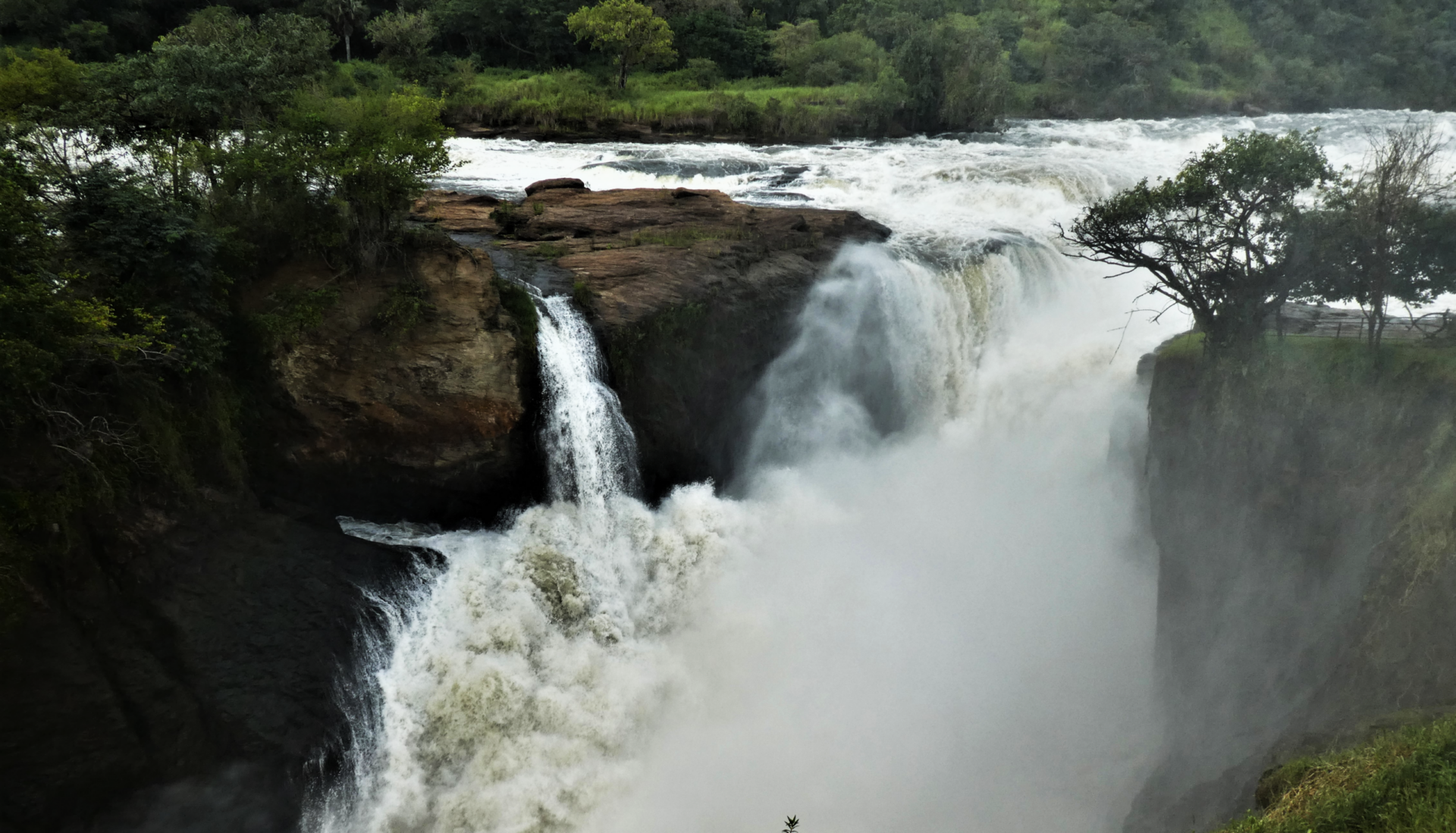
Murchison Falls, where the Nile River forces itself through a narrow gorge before plunging 43 meters, is one of Uganda’s most spectacular natural wonders. The sheer power of the falls is awe-inspiring, with 300 cubic meters of water squeezing through a gap just seven meters wide.
A visit to the falls offers more than just visual spectacle. Hiking to the top of the falls provides panoramic views of the surrounding national park and the opportunity to feel the spray on your face. For a different perspective, boat trips to the base of the falls allow you to appreciate their magnitude from below.
The area around the falls is rich in wildlife, with crocodiles basking on the banks and a variety of birds, including the rare shoebill stork. The falls aren’t just a tourist attraction; they’re a vital part of the ecosystem, creating diverse habitats and influencing the entire region’s biodiversity.
Witnessing Murchison Falls is experiencing one of nature’s most impressive displays of raw power and beauty.
Whitewater Thrills: Brave the rapids of the mighty Nile
The section of the Nile near the town of Jinja offers some of the best whitewater rafting in the world. With rapids ranging from grade III to V, it caters to both beginners and experienced rafters.
The experience begins calmly, allowing you to adjust to the river’s flow, before plunging into heart-pumping rapids with names like “The Bad Place” and “Itanda Falls”. Between the rapids, there are calm stretches where you can catch your breath, take in the lush riverbank scenery, and spot various bird species.
Many operators offer full-day trips, including a riverside lunch, making it a comprehensive adventure. Safety is a top priority, with experienced guides and top-quality equipment ensuring a thrilling yet secure experience.
Beyond the adrenaline rush, rafting the Nile connects you with the river’s immense historical and cultural significance. It’s a unique way to experience the power of Africa’s mightiest river, combining excitement with natural beauty and a touch of historical awe.
Primate Paradise: Encounter diverse monkey species in lush forests
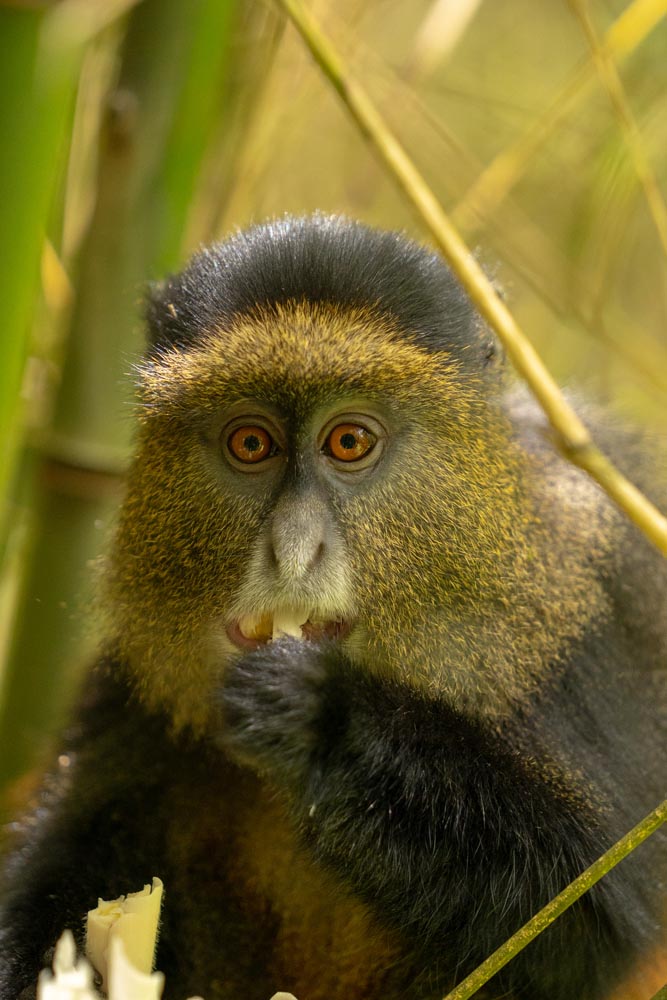
While gorillas and chimpanzees often steal the spotlight, Uganda is home to a remarkable diversity of primate species, making it a true primate paradise. Kibale National Park alone hosts 13 primate species, including the rare L’Hoest’s monkey and the striking red colobus monkey. In Bigodi Wetland Sanctuary, adjacent to Kibale, you can spot grey-cheeked mangabeys and black-and-white colobus monkeys.
Queen Elizabeth National Park is home to olive baboons and vervet monkeys, often seen during game drives. The golden monkey, with its distinctive bright orange coat, can be tracked in Mgahinga Gorilla National Park.
These diverse primate encounters offer more than just photo opportunities; they provide insights into complex social behaviors and evolutionary adaptations. Many of these species play crucial roles in forest ecosystems as seed dispersers.
Primate walks, often led by knowledgeable local guides, allow for intimate observations of these fascinating creatures in their natural habitats, contributing to a deeper understanding and appreciation of Uganda’s rich biodiversity.
Ugandan Hospitality: Feel the warmth of Africa’s friendliest people
Uganda’s reputation as “Africa’s friendliest country” is well-earned, with hospitality deeply ingrained in its diverse cultures. Visitors often remark on the genuine warmth and welcoming nature of Ugandans, from the streets of Kampala to remote villages.
This hospitality manifests in various ways: a shopkeeper’s cheerful greeting, a stranger’s offer to help with directions, or a village elder’s invitation to share a meal. In many communities, visitors are welcomed with traditional dances and ceremonies, providing insight into local customs and fostering cultural exchange.
Ugandan guides often go above and beyond to ensure visitors have memorable experiences, sharing personal stories and local knowledge that enrich the journey. This warmth extends to the service industry, where staff at lodges and restaurants genuinely seem to enjoy interacting with guests.
The Ugandan spirit of hospitality transforms a simple trip into a heartwarming human experience, creating lasting connections and memories. It’s this genuine friendliness that often leaves the most lasting impression on visitors, long after the wildlife sightings and scenic vistas have faded from memory.
Book Your Next Uganda Safari With Kikooko Africa Safaris

Ready to turn these 25 reasons into one unforgettable experience? Let Kikooko Africa Safaris be your guide to the wonders of Uganda.
Our expert team is passionate about sharing the beauty and magic of our home country with you. We offer tailored safari experiences that cater to your interests, whether it’s gorilla trekking, birdwatching, cultural tours, or a combination of adventures. Get in touch today to get started.





















